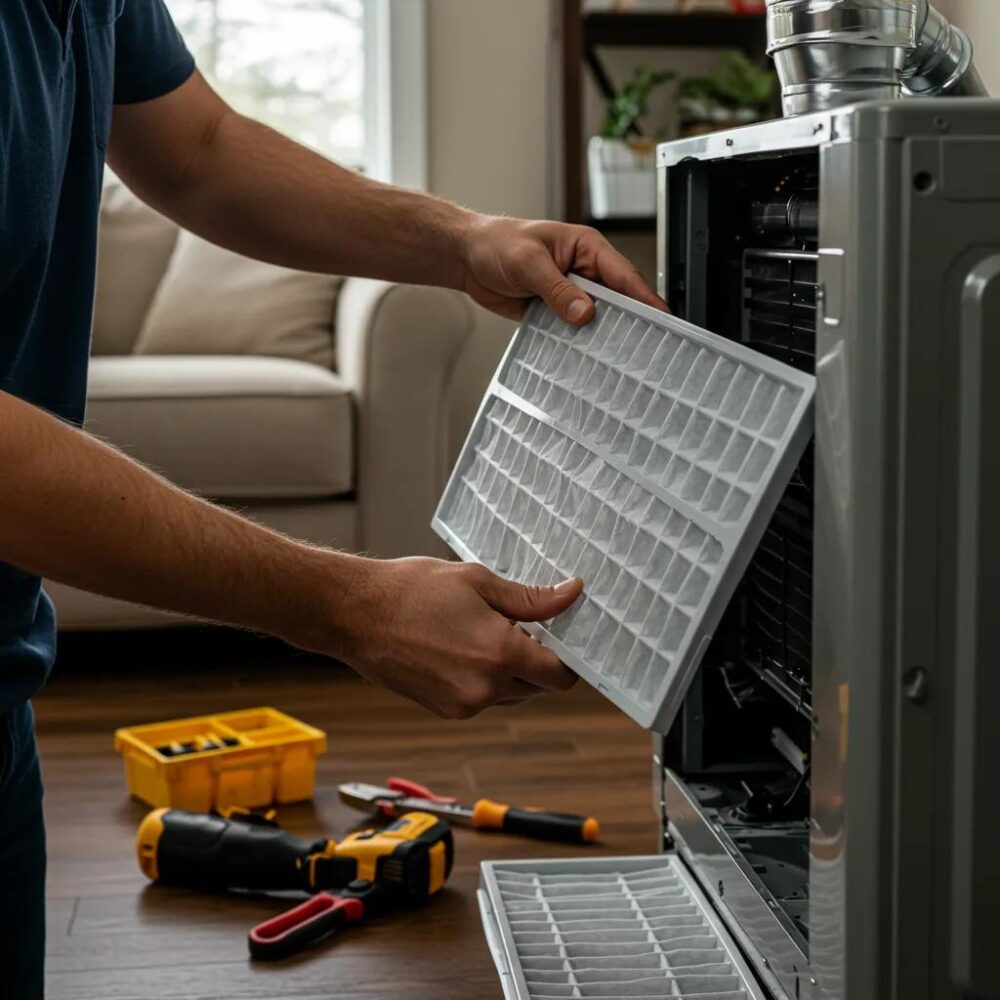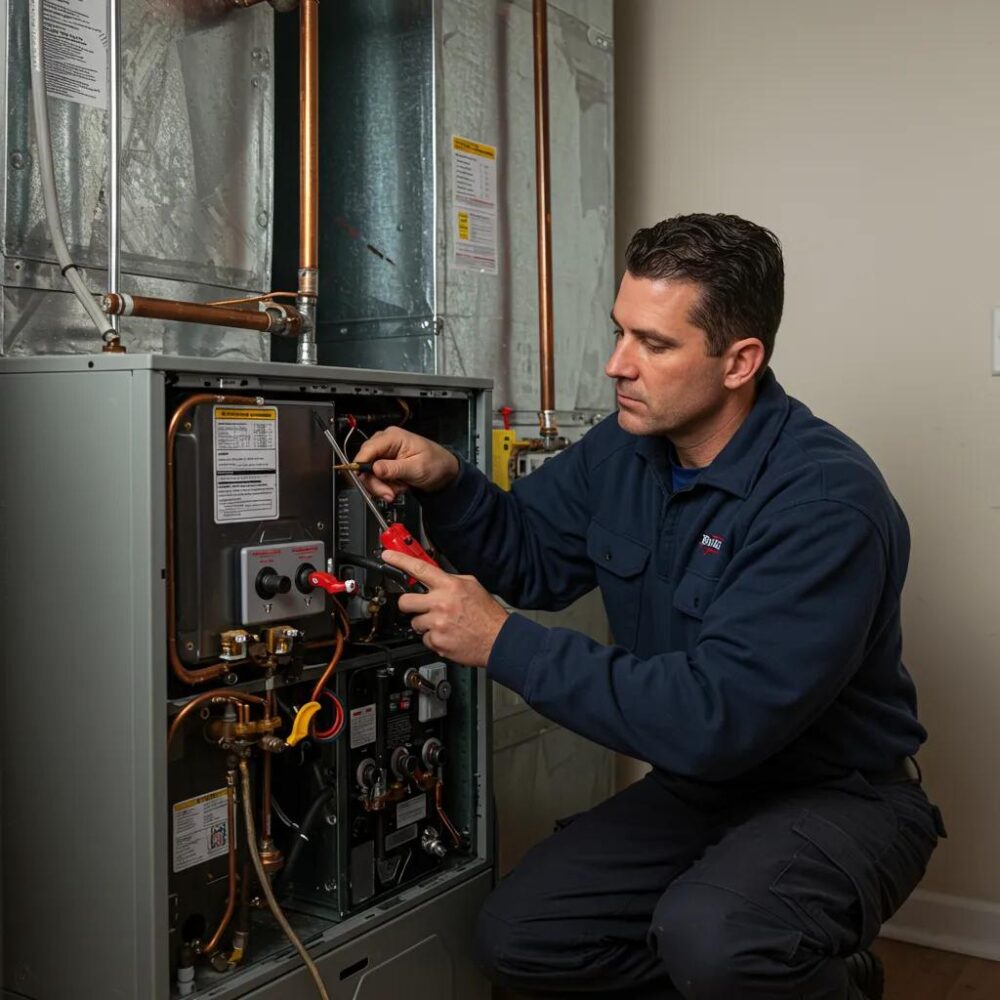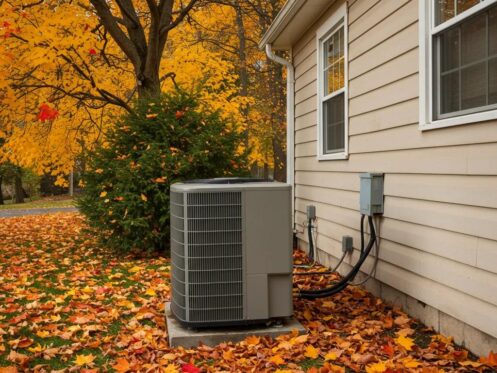Fall HVAC Maintenance Checklist: Essential Steps for Heating System Tune-Up and Winter Preparation
Getting your heating, ventilation, and air conditioning (HVAC) system ready each fall means reliable warmth, better efficiency, and enhanced safety when colder weather hits. This fall HVAC maintenance checklist covers DIY tasks, professional tune-up advice, and energy-saving tips for homeowners and businesses in Los Angeles County and Antelope Valley. You’ll discover why seasonal heating maintenance is so important, which checks you can do yourself, when to call in the pros, and how affordable, proactive care from a local expert keeps you comfortable all year.
Throughout this guide, we’ll dive into four main areas for your heating system tune-up and winter prep:
- The vital benefits of fall HVAC maintenance.
- Key DIY inspection and cleaning tasks.
- What professional service includes.
- Energy optimization, safety measures, and local service options.
By following these steps, you’ll help your system last longer, lower your energy bills, and ensure great indoor air quality before winter’s demands ramp up.
Why Is Fall HVAC Maintenance Crucial for Homeowners and Businesses?
Seasonal HVAC maintenance is a structured inspection and service routine done each fall to get your heating system ready for the cold. This process helps prevent unexpected breakdowns, keeps your home consistently comfortable, and guards against safety risks like carbon monoxide leaks. For instance, a family in Antelope Valley avoided a costly mid-winter repair by doing a pre-season check and changing their filter. Understanding these benefits sets the stage for exploring specific maintenance tips, efficiency boosts, and safety priorities.
What Are the Key Benefits of Seasonal HVAC Maintenance?
- Energy Savings – Keeping components clean and controls calibrated cuts down on fuel or electricity use.
- System Longevity – Lubricating moving parts and tightening connections reduces wear and tear.
- Improved Air Quality – Swapping out filters and checking ducts removes dust, allergens, and pollutants.
These results mean lower utility bills, fewer emergency calls, and healthier indoor air as winter approaches.
How Does Fall Maintenance Improve Energy Efficiency and Indoor Air Quality?
Regular fall tune-ups optimize airflow and heat transfer by cleaning coils, checking refrigerant levels, and sealing duct leaks. Better airflow means your compressor or burner doesn’t have to run as long, cutting energy use by up to 20 percent. At the same time, replacing clogged filters and vacuuming supply vents removes airborne particles, improving indoor air quality for anyone with allergies or breathing issues.
Why Is Carbon Monoxide Safety Important During Fall HVAC Checks?
Carbon monoxide is an odorless gas produced when furnaces and boilers don’t burn fuel completely. Testing and servicing heat exchangers, inspecting flue venting, and verifying that detectors are working ensures that combustion by-products vent safely. Catching cracks or blockages early prevents dangerous exposure and protects your family or staff from potential poisoning.
Preventing Carbon Monoxide Poisoning: Annual Furnace Inspections and CO Alarms
Residential poisonings attributed to faulty furnaces represent the most frequent form of CO exposure. Nevertheless, these poisonings are largely preventable through annual furnace inspections and the installation of CO alarms.
Risk and protective behaviours for residential carbon monoxide poisoning, JA Poehlman, 2013
What Are the Essential DIY Tasks on a Fall HVAC Maintenance Checklist?

DIY fall tasks include simple, budget-friendly actions homeowners and business managers can do before calling a technician. These checks and cleanings boost system performance and can reveal issues that need professional attention. Tackling these four steps now will make any follow-up service calls smoother and help your equipment last longer.
How to Inspect and Replace Your HVAC Air Filter for Fall?
Start by finding the filter housing, then pull out and check the air filter for dirt. A clean filter allows for efficient airflow and can capture up to 95 percent of airborne particles with higher-rated filters. Replace standard pleated filters every 90 days, or sooner if they look dirty. Aim for a filter rated filter rated MERV 8–13 for a good balance between filtering power and system compatibility.
| Filter Type | MERV Rating | Typical Efficiency |
|---|---|---|
| Fibreglass flat panel | 1–4 | Basic dust removal |
| Pleated polyester | 5–8 | Residential allergen control |
| High-performance pleated | 9–13 | Commercial-grade pollutant capture |
Choosing the right filter helps maintain airflow while maximizing indoor air purification, setting the stage for thermostat calibration and outdoor unit care.
How Can You Optimise Thermostat Settings for Autumn Energy Savings?
After changing your filter, test your programmable or smart thermostat by setting back the temperature when you’re away or asleep. Lowering the temperature by 7–10 °F for eight hours a day can cut heating costs by up to 10 percent. Program a gradual temperature increase before you return to avoid feeling chilly. Smart thermostats learn your habits and adjust automatically, further improving seasonal energy management.
What Steps Should You Take to Clear Debris from the Outdoor HVAC Unit?
Clearing leaves, grass clippings, and dust from outdoor coils and the area around the unit keeps airflow unrestricted. First, turn off the power at the disconnect box. Gently brush away debris, then rinse the coils with a low-pressure stream to avoid damaging the fins. Remove any plants or vegetation within a 2-foot radius and make sure the unit is on a stable, level base. These steps ensure efficient heat exchange and prevent unnecessary strain on the compressor.
How to Check and Clean Vents and Registers for Proper Airflow?
Look for anything blocking your supply and return vents, like furniture, curtains, or built-up dust. Take off the vent covers and vacuum inside the duct openings to remove trapped debris. Wipe down the registers with a mild detergent solution, then dry them completely before putting them back. Making sure these passages are clear helps distribute heat evenly throughout your rooms.
When Should You Call a Professional for Fall HVAC Maintenance and Repairs?
While DIY tasks are a great start for system reliability, some inspections and repairs need certified expertise to ensure safety and performance. Knowing the warning signs and understanding what professional service involves will help you schedule the right help at the right time.
What Are the Signs You Need a Furnace Inspection or Tune-Up?
If your pilot light frequently goes out, heating is uneven across different rooms, you hear strange noises when it starts up, or your utility bills are climbing even though you change the filter regularly, it’s time for a professional furnace inspection. A technician will check the heat exchanger’s condition, burner combustion, and blower motor function to get it running optimally and safely.
Which HVAC Tasks Require Expert Attention Beyond DIY?
Complex jobs like measuring refrigerant charge, testing heat exchangers for cracks, replacing electrical parts, and advanced airflow diagnostics should always be handled by a licensed technician. Trying these yourself without the right tools and training can damage your equipment, cause injury, or void your manufacturer’s warranty.
How Does a Professional Fall Tune-Up Extend HVAC System Lifespan?
During a professional fall tune-up, technicians conduct thorough inspections of all components, clean condensate drains, lubricate motors, tighten electrical connections, and test system controls. This proactive maintenance catches potential problems before they lead to major failures. As a result, your heating equipment can operate reliably for many years beyond its expected service life.
What Does a Professional Fall HVAC Tune-Up Include?

A complete professional fall HVAC tune-up involves systematic checks and servicing of all heating system parts. Skilled technicians follow industry best practices to ensure safety, efficiency, and warranty compliance.
How Are Furnace and Boiler Systems Inspected and Maintained?
Certified technicians inspect heat exchangers for rust or cracks, test gas pressure and combustion efficiency, adjust burner settings, and confirm safe venting. Boiler checks include looking at water levels, pressure relief valves, and the circulator pump. Keeping records of maintenance helps track performance over time.
What Are the Steps for Outdoor Unit Winterisation by Technicians?
Professionals clear debris from condenser coils, check fan blades for damage, test defrost cycles on heat pumps, and install protective covers if needed. Electrical connections get moisture-resistant treatment, and refrigerant line insulation is checked to prevent freezing in cold weather.
How Do Professionals Test and Calibrate Thermostats for Fall?
Technicians use precise tools to verify temperature accuracy and sensor responsiveness. They recalibrate programmable settings, ensure wireless connections for smart thermostats are working, and suggest usage patterns that match your schedule and local climate.
How Can You Maximise Energy Savings with Preventative HVAC Maintenance in Fall?
Preventative maintenance uses fall tune-up activities to lower energy use and heating costs all winter long. By sealing leaks, optimizing controls, and integrating smart devices, you can achieve lasting efficiency improvements.
What Are the Best Practices for Sealing Air Leaks and Ductwork?
Sealing gaps and insulating accessible ducts minimizes the loss of conditioned air. Use mastic sealant or metal-faced foil tape on joints and seams, and wrap exposed ducts with R-6 or higher insulation. Properly sealed ductwork can boost system efficiency by 10–20 percent and deliver more consistent temperatures room to room. You can read more about benefits of new ductwork.
| Location | Sealing Method | Impact on Efficiency |
|---|---|---|
| Duct joints | Mastic sealant | Reduces leakage |
| Duct seams | Foil-backed tape | Eliminates air loss |
| Attic/floor plenums | Fibreglass insulation | Minimises thermal transfer |
Applying these measures creates a stable thermal envelope, reducing heating runtimes and fuel consumption.
How Does Regular Maintenance Reduce Heating Costs in Winter?
Routine filter changes, coil cleaning, and professional tune-ups prevent buildup and mechanical friction that make systems work harder. Consistent airflow and correct refrigerant or gas pressure shorten heating cycles, providing the same comfort with less energy use. Over time, these savings add up significantly.
What Role Do Smart Thermostats Play in Fall HVAC Energy Management?
Smart thermostats learn when you’re home, adjust temperatures automatically, and provide usage data to optimize heating schedules. They can connect with home automation systems and be controlled remotely via mobile apps for adjustments on the go. Smart setback strategies can lower heating bills by an additional 5–10 percent compared to manual programming.
How to Ensure HVAC System Safety During Fall: Carbon Monoxide and Emergency Preparedness
Fall inspections enhance both comfort and safety by focusing on combustion integrity and preparing for potential emergencies. Proactive detection and planning help prevent dangerous failures when heating demand is highest.
How to Detect and Prevent Carbon Monoxide Leaks in Furnaces?
Install or test carbon monoxide alarms near your furnace and living areas. Schedule professional combustion analysis to measure flue gas levels and identify incomplete combustion. Sealing cracks in heat exchangers and verifying vent pipe integrity prevents CO from entering your indoor air.
What Are Common HVAC Malfunctions to Watch for in Fall?
Listen for unusual sounds like rattling, hissing, or banging when your system starts up, as these can indicate loose parts, refrigerant leaks, or ignition problems. Pay attention to incomplete cycles, flames that roll out of the burner area, or strange exhaust smells, which suggest burner or venting issues that need immediate attention.
When and How to Handle Emergency Heating Repairs?
If your system completely shuts down, the pilot light fails, or you detect gas leaks, turn off the power and gas supply immediately, evacuate if necessary, and call for emergency HVAC service. Having a maintenance contract with guaranteed fast response ensures you get priority help during critical winter periods.
Where to Find Reliable Local Fall HVAC Maintenance Services in Los Angeles County and Antelope Valley?
Choosing a trusted local provider means getting timely seasonal tune-ups, personalized service plans, and compliance with local regulations. Local expertise helps tailor maintenance to Southern California’s specific climate and building types.
Why Choose Affordable Air and Heating for Your Fall HVAC Needs?
Affordable Air and Heating specializes in preventative fall maintenance throughout Los Angeles County and Antelope Valley. With certified technicians, clear pricing, and a commitment to affordability, we protect your indoor comfort and air quality. Our experienced team works on both residential and commercial systems, using advanced diagnostic tools to provide reliable tune-ups and recommendations.
How to Schedule Your Fall HVAC Maintenance Appointment?
Contact us by phone or use the service request form on our website to book your fall inspection. Provide your address, system type, and preferred appointment time. A member of our customer service team will confirm your booking and let you know what to prepare, like having filters ready or ensuring access to the outdoor unit.
What Are the Available HVAC Maintenance Plans and Service Contracts?
Affordable Air and Heating offers different fall maintenance plans that include:
- Basic Tune-Up Plan – Annual inspection, filter replacement, and safety checks.
- Comprehensive Care Plan – All basic services plus duct sealing, coil cleaning, and thermostat calibration.
- Premium Protection Plan – Two service visits per year, priority emergency response, and discounted repair rates.
Each plan comes with detailed service reports, verification of warranty compliance, and energy-saving advice tailored to your property.
Preventative fall maintenance is the best way to ensure your heating works well, your energy use is optimized, and everyone stays safe. By combining simple DIY checks with professional tune-ups and relying on trusted local experts, you can face winter with confidence in your HVAC system’s reliability and efficiency. Contact Affordable Air and Heating today to schedule your autumn service and enjoy uninterrupted comfort all season long.




